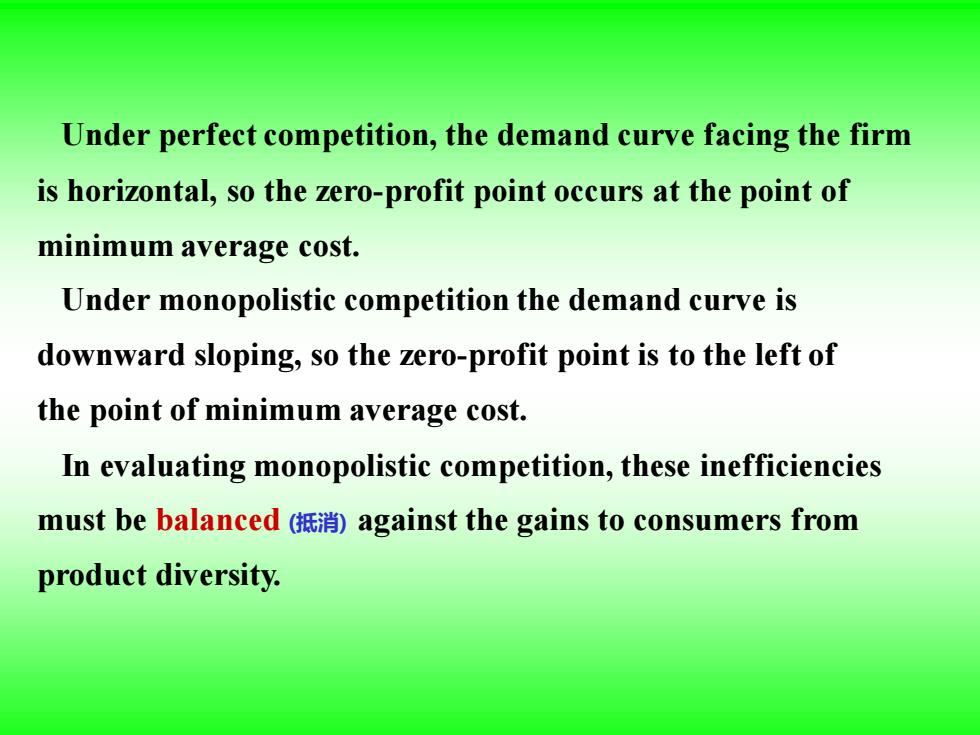
Chapter 12 Monopolistic Competition and Oligopoly Chapter Outline Monopolistic Competition ·Oligopoly(寡头垄断) ·Price Competition Competition versus Collusion:The Prisoners' Dilemma for Oligopolistic Pricing 。Cartels
Chapter 12 Monopolistic Competition and Oligopoly Chapter Outline • Monopolistic Competition • Oligopoly (寡头垄断) • Price Competition • Competition versus Collusion: The Prisoners’ Dilemma for Oligopolistic Pricing • Cartels

12.1 Monopolistic Competition Monopolistic competition-Market in which firms can enter freely,each producing its own brand or version of a differentiated product. Oligopoly-Market in which only a few firms compete with one another,and entry by new firms is impeded. Cartel-Market in which some or all firms explicitly collude, coordinating prices and output levels to maximize joint profits
12.1 Monopolistic Competition Monopolistic competition - Market in which firms can enter freely, each producing its own brand or version of a differentiated product. Oligopoly - Market in which only a few firms compete with one another, and entry by new firms is impeded. Cartel - Market in which some or all firms explicitly collude, coordinating prices and output levels to maximize joint profits

$/Q $/Q MC MC AC AC PsR P DSR 08 MRsR MRLR QSR Quantity QLR Quantity (a) 6) A Monopolistically Competitive Firm in the Short and Long Run
A Monopolistically Competitive Firm in the Short and Long Run

Because the firm is the only producer of its brand,it faces a downward-sloping demand curve: Price exceeds marginal cost and the firm has monopoly power. In the short run described in part (a),price also exceeds average cost,and the firm earns profits shown by the shaded rectangle
Because the firm is the only producer of its brand, it faces a downward-sloping demand curve: Price exceeds marginal cost and the firm has monopoly power. In the short run described in part (a), price also exceeds average cost, and the firm earns profits shown by the shaded rectangle

In the long run,these profits attract new firms with competing brands.The firm's market share falls,and its demand curve shifts downward. In long-run equilibrium,described in part (b),price equals average cost,so the firm earns zero profit,even though it has monopoly power
In the long run, these profits attract new firms with competing brands. The firm's market share falls, and its demand curve shifts downward. In long-run equilibrium, described in part (b), price equals average cost, so the firm earns zero profit, even though it has monopoly power

MC AC MC AC Pe PMC D=MR MR Q. Quantity Cvc Quantity (a) ) Comparison of Monopolistically Competitive Equilibrium and Perfectly Competitive Equilibrium
Comparison of Monopolistically Competitive Equilibrium and Perfectly Competitive Equilibrium

Under perfect competition,as in (a),price equals marginal cost, but under monopolistic competition,price exceeds marginal cost, so there is a deadweight loss as shown by the shaded area in (b). In both type of markets,entry occurs until profits are driven to zero
Under perfect competition, as in (a), price equals marginal cost, but under monopolistic competition, price exceeds marginal cost, so there is a deadweight loss as shown by the shaded area in (b). In both type of markets, entry occurs until profits are driven to zero

Under perfect competition,the demand curve facing the firm is horizontal,so the zero-profit point occurs at the point of minimum average cost. Under monopolistic competition the demand curve is downward sloping,so the zero-profit point is to the left of the point of minimum average cost. In evaluating monopolistic competition,these inefficiencies must be balanced (against the gains to consumers from product diversity
Under perfect competition, the demand curve facing the firm is horizontal, so the zero-profit point occurs at the point of minimum average cost. Under monopolistic competition the demand curve is downward sloping, so the zero-profit point is to the left of the point of minimum average cost. In evaluating monopolistic competition, these inefficiencies must be balanced (抵消) against the gains to consumers from product diversity

12.2 Oligopoly Nash equilibrium-Set of strategies or actions in which each firm does the best it can given its competitors'actions. Duopoly-Market in which two firms compete with each other. Cournot model-Oligopoly model in which firms produce a homogeneous good,each firm treats the output of its competitors as fixed,and all firms decide simultaneously how much to produce
12.2 Oligopoly Nash equilibrium - Set of strategies or actions in which each firm does the best it can given its competitors’ actions. Duopoly - Market in which two firms compete with each other. Cournot model - Oligopoly model in which firms produce a homogeneous good, each firm treats the output of its competitors as fixed, and all firms decide simultaneously how much to produce

Pi D1(0) MR1(0) MC1 MR1(75) MR1(50)D1(75) p50 12.5 25 50 75 Q1 Firm 1's Output Decision
Firm 1’s Output Decision